The intended part size, complexity, and production volume are just a few of the many variables that must be carefully taken into account when choosing the best CNC milling machine for brass and copper parts. This is a thorough guide to help you select the best CNC milling machine for the machining of brass and copper:
1. Part Size and Complexity:
- Consider the maximum part size: Establish the largest dimensions of the workpiece that you plan to machine. Your desired part size should be accommodated by the machine's travel limits and worktable size.
- Assess part complexity: Assess the intricacy of the components you intend to manufacture. Intricate geometries, close tolerances, or multiple axes of movement may call for a more sophisticated machine with greater precision and capabilities.
2. Production Volume:
- Estimate production volume: Estimate how many parts you will need to make. Think about getting a machine with multiple spindles, automated tool changers, or faster machining speeds if you need to achieve high production rates.
- Evaluate machine durability: Select a machine that is capable of withstanding the demands of regular production runs. Take into account variables such as tool life expectancy, spindle power, and machine rigidity.
3. Material Compatibility:
- Ensure brass and copper compatibility: Make sure the machine is capable of processing copper and brass. For these materials, some machines might need to use particular tool holders, cutting fluids, or spindle configurations to operate at their best.
- Consider material removal rates: Select a machine that can manage the material removal rates needed for copper and brass, with enough spindle power and torque. When cutting these materials, greater cutting forces might be needed than with softer materials.
4. Machine Features and Capabilities:
- Precision and accuracy: To make sure the machine satisfies your tolerance requirements, consider its precision and accuracy specifications. Take into account elements such as encoder feedback systems, servo motor resolution, and ball screw accuracy.
- Control system: Select a machine that works with your CAD/CAM software and has an easy-to-use control system. Think about things like machine monitoring capabilities, graphical user interface, and programming ease.
- Tooling options: Assess the machine's tool-holding mechanism and suitability for the cutting tools that you prefer. Take into account elements such as tool changer options, spindle taper, and tool shank size.
- Automation and robotics: If you need to perform repetitive tasks or high-volume production, consider whether automation or robotics are necessary. Think about features like robotic loading/unloading systems, pallet changers, and automated tool changers.
5. Machine Maintenance and Support:
- Evaluate service availability: Make sure the machine's distributor or manufacturer offers dependable and timely service support in your region. Think about things like technical know-how, availability of parts, and response times.
- Consider maintenance requirements: Assess the machine's ease of maintenance and maintenance schedule. Think about things like service manual availability, accessibility, and lubrication points.
- Assess warranty coverage: Examine the machine's warranty details and coverage to learn about the manufacturer's dedication to high-quality products and customer service.
You can choose the best CNC milling machine for your particular needs in brass and copper machining by carefully weighing these factors. This will ensure effective production, durable parts, and a good return on investment.








